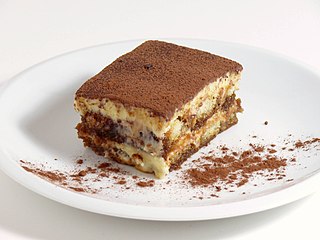
Tiramisu is an Italian dessert made of ladyfinger pastries dipped in coffee, layered with a whipped mixture of egg yolks, sugar, and mascarpone, and flavoured with cocoa powder. The recipe has been adapted into many varieties of cakes and other desserts. Its origin is disputed between the Italian regions of Veneto and Friuli-Venezia Giulia. The name comes from the Italian tirami su.
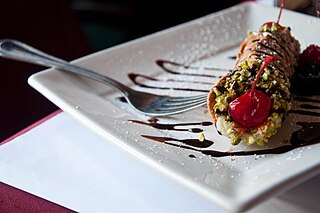
Cannoli are Sicilian pastries consisting of a tube-shaped shell of fried pastry dough, filled with a sweet, creamy filling containing ricotta cheese. Their size ranges from 9 to 20 centimetres. They have since spread to mainland Italy, where they are known as cannolo siciliano.

Biscotti are Italian almond biscuits originating in the city of Prato, Tuscany. They are twice-baked, oblong-shaped, dry, and crunchy. In Italy, they are known as cantucci, biscotti di Prato or biscotti etruschi and may be dipped in a drink, traditionally Vin Santo. Smaller biscotti may be known as biscottini or cantuccini. In Italian, the word biscotti encompasses all types of biscuits or cookies.

Panzerotti, also known as panzarotti, are savory turnovers, originating in the Apulia region of Italy, which resemble small calzones, both in shape and dough used for their preparation. The term usually applies to a fried turnover rather than an oven-baked pastry, although calzones and panzerotti are often mistaken for each other.

Biscotti regina, also known as reginelle, are small Sicilian biscuits coated with sesame seeds. They are typical of the province of Palermo but are also widespread in other Sicilian provinces. These pastries taste halfway between sweet and salty (savoury).
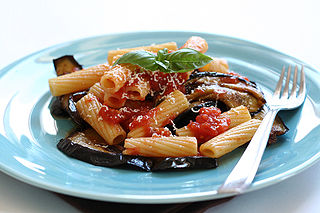
Pasta alla Norma, earlier called pasta con le melanzane, is a pasta dish made from eggplant. It is typical of Sicilian cuisine, from Catania in particular.
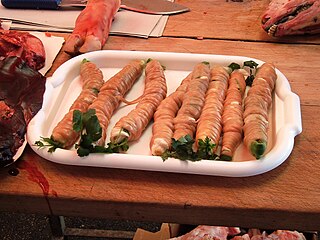
The stigghiola, also known as stigghiuola, is a Sicilian food typical of the streets of the city of Palermo. It consists of guts which are washed in water and salt, seasoned with parsley and often with onion and other pot herbs, then stuck on a skewer or rolled around a leek, and finally cooked directly on the grill. The dish is generally prepared and sold as a street food. In Ragusa, the dish is baked in a casserole and is known as turciniuna.

'Nzuddi are traditional cookies typical of the Italian provinces of Messina and Catania. They are spherical, slightly flattened, golden-colored cookies, made of flour, sugar, almonds, cinnamon, egg whites, and ammonia.

The gelo di melone, also known as gelo d'anguria, is a typical Sicilian dessert, traditionally prepared in Ferragosto. A jellied watermelon pudding, it is also popular for the Saint Rosalia celebrations in Palermo.
Spongarda is a local cake originating in the comune (municipality) of Crema. The Lombardy region includes it as spongarda of Crema in the list of traditional food products.
Giuseppe Casarrubea was an Italian historian and author.

Ligurian cuisine consists of dishes from the culinary tradition of Liguria, a region of northwestern Italy, which makes use of ingredients linked both to local production, and to imports from areas with which, over the centuries, the Ligurians have had frequent trade.

The cuisine of Basilicata, or Lucanian cuisine, is the cuisine of the Basilicata region of Italy. It is mainly based on the use of pork and sheep meat, legumes, cereals and vegetables, with the addition of aromas such as hot peppers, powdered raw peppers and horseradish. The local gastronomy is, for historical-cultural reasons, typically peasant, based on simple recipes and on the culture of reuse, in particular of meat and bread.
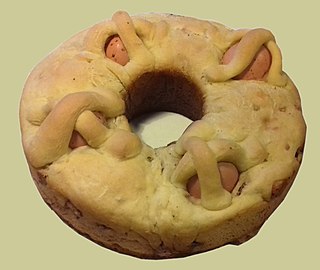
Casatiello is a leavened savory bread originating from Naples prepared during the Easter period.

Salvatore Farina is an Italian essayist, cultural researcher, teacher and photographer.

The rollò, or rollò nisseno, or ricotta roll from Caltanissetta, is a typical dessert from the Nisseno area, produced by local pastry chefs. It is consumed year-round, as it is not tied to any specific event or occasion. This dessert, along with the ricotta raviola, originated in Caltanissetta.

The Raviola di ricotta nissena or Nissena ricotta ravioli is a fried dessert made with puff pastry and ricotta filling typical of the city of Caltanissetta; not to be confused with the fried raviola from Catania which is similar in shape but not in dough.
The guasteddra dolce nissena or guastedda is a typical dessert of the city of Caltanissetta tradition. The word guastedda being a cacuminal or retroflex phoneme is written guastedda and pronounced guasteddra, it is represented with the symbol [ɖ] in the international phonetic alphabet (IPA); this phoneme is not present in the Italian language.

The cassatella di Agira T are traditional sweets from the Enna gastronomy, originating in the town of Agira and widely found not only in the province of Enna but throughout much of eastern Sicily. As a typical Sicilian product, they have been officially recognized and included in the list of traditional Italian agri-food products (P.A.T) by the Ministry of Agricultural, Food and Forestry Policies (Mipaaf).

Biscotto di San Martino are traditional Sicilian biscuits, which are prepared for the feast of San Martino di Tours on November 11.
















